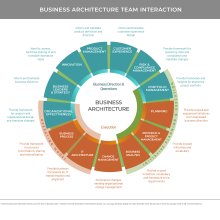Remember way back to StraightTalk Post No. 1 when we talked about what business architecture is and a whole bunch about what it is not? That’s because business architecture has a lot of friends that it needs to work within an organization’s ecosystem.
Okay, what’s this all about?
The bottom line is that to be successful, business architects cannot work as an isolated function. It’s not about creating enterprise maps and expecting magic to happen when people see them. Business architects work within a bigger ecosystem and must always remain cognizant of their role as an enabler of other teams.
Yes, business architecture has value on its own as a common enterprise language and “mental model” for an organization, but its true value is realized when it is used to help other teams be even more effective and successful at what they do.
Tell me more.
By nature, business architecture is about connecting dots. The business architecture knowledgebase has to connect to a lot of different things: strategies, initiatives, customer journeys, and the more detailed aspects of the operating model (think people, process and technology). And business architects very much act as dot connectors as well. (Remember Connect Four? Business architects were really good at that game.)
What sort of dots do business architects connect?
Business architects help to connect:
- Strategy to execution, by translating business direction into actionable business and IT changes and scoped initiatives
- Business people to other business people, through knowledge of designs and plans across business units and products
- Business to IT, by working with IT architects to synch up business strategy and architecture with IT strategy and architecture
- Everyone to everyone, by facilitating a true common language and way that the organization sees itself
Which teams do business architects work with?
Business architects interact with a common set of teams, which generally fall into two categories.
The first category relates to teams which set business direction and/or run the operations of an organization. This includes teams such as strategy, innovation, product management, customer experience, risk and compliance management, portfolio management and organizational effectiveness.
The second category relates to teams which collaborate with the business architecture team at various points across the strategy execution life cycle to implement business direction together. This includes teams such as planning, program and project management, business analysis, change management, IT architecture (data and application architecture in particular) and business process.
These teams were just fine before you came along. How does business architecture help?
The business direction and operations-related teams leverage the enterprise business architecture framework and expertise of business architects to inform business direction and decisions as well as translate them into concrete changes which need to be made to the business and IT environment.
The execution-related teams exchange various inputs and outputs with the business architecture team and work closely together to define, design, plan, execute and measure the success of business direction. As you know, getting business direction into action across an organization is a team sport, requiring all of these players to work together—and business architecture has been that missing puzzle piece right in the middle, serving as the translator and bridge.
Here’s the part where you get a cool picture. How business architecture interacts with other teams: summarized below. Click image to enlarge.
So, what next then?
Business architecture teams must deliberately integrate with all other related teams. It takes focused effort and partnership to make this happen.
How do we do that, especially if business architecture is a new concept in our organizations?
One step at a time. Like this:
- Identify all of the teams that your business architecture team should interact with. Write them down and describe what the interactions are. If you want to be fancy and use industry-speak, you can call it an “engagement model.” (Hint: Use the illustration in this blog post as your checklist to know who to look for. Yay StraightTalk.)
- Prioritize the list of teams.
- In priority order, start having conversations with each team to discuss the value of business architecture and how you will interact and collaborate.
- Over time, your relationship with each team will progress from awareness to partnership (where you work together to leverage business architecture) to full integration (where each of your teams’ procedures and roles reflect the others’).
And what happens if we do all of this?
Business architecture integration nirvana is when business architecture and business architects are fully integrated into the strategy execution life cycle as well as with each related team. With business architecture, teams should be even more successful than they are today and they should all work together seamlessly to move business direction into action from a business-focused, top-down, and enterprise perspective.
When people ask for business architecture, when it is integrated into the very fabric of an organization, when business architecture becomes “just how the organization does business”—you will know that you’ve arrived.
More good stuff…
Business Architecture Integration (S2E White Paper): A longer version of this story on how business architecture interacts with other teams and what you need to do to formally integrate with them.
Business Architecture Integration Industry References: Here’s your Summer Reading List (or Winter Reading List if you’re south of the equator) on how business architecture integrates with other key teams. A LOT of incredible integration work has been done by the Business Architecture Guild® and the business architecture community as well as other professional associations and their communities. The ground work that has been laid by these people to drive clarity and consensus around the business architecture discipline and its integration points has truly shaped the discipline and paved the way for future practitioners. Check out these Business Architecture Guild® White Papers on the Public Resources page (and of course the BIZBOK® Guide):
- Linking Business Models with Business Architecture to Drive Innovation
- Business Architecture and the Customer Experience: A Comprehensive Approach for Turning Customer Needs into Action
- Business Architecture and BPM: Differentiation and Reconciliation
- Leveraging Business Architecture to Improve Business Requirements Analysis
- Business Architecture and Agile Methodologies
- Aligning Business Architecture and the Scaled Agile Framework®
(P.S. Don’t worry, we’ll StraightTalk on every one of these topics over time.)
Build a Tower, Build a Team (TED Talk): Lessons on team collaboration from Tom Wuject in this TED Talk. (And if you haven’t done this marshmallow challenge with your team, try it!)

